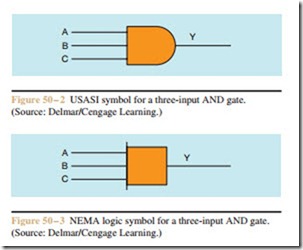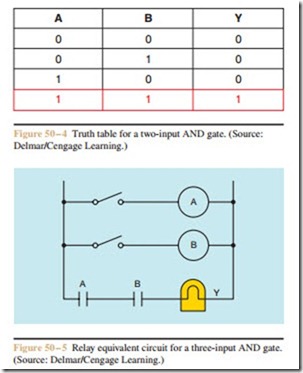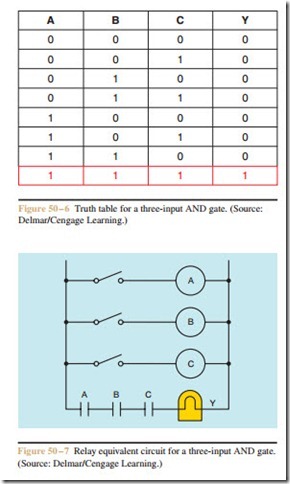The electrician in today’s industry must be familiar with solid-state digital logic circuits. Digital, of course, means a device that has only two states, ON or OFF. Most electricians have been using digital logic for many years without realizing it. Magnetic relays, for instance, are digital devices. Relays are generally considered to be single-input, multi-output devices. The coil is the input and the contacts are the output. A relay has only one coil, but it may have a large number of contacts (Figure 50 – 1).
Although relays are digital devices, the term “digital logic” has come to mean circuits that use solid-state control devices known as gates. There are five basic types of gates: the AND, OR, NOR, NAND, and IN- VERTER. Each of these gates will be covered later in this text.
There are also different types of logic. For instance, one of the earliest types of logic to appear was RTL, which stands for resistor-transistor logic. This was fol- lowed by DTL, which stands for diode-transistor logic,
and TTL, which stands for transistor-transistor logic.
RTL and DTL are not used much anymore, but TTL is still used to a fairly large extent. TTL can be identified because it operates on 5 volts.
Another type of logic frequently used in industry is because it does a better job of ignoring the voltage spikes and drops caused by the starting and stopping of inductive devices such as motors. HTL generally operates on Figure 50 – 2 USASI symbol for a three-input AND gate.
Another type of logic that has become very popular is CMOS, which has very high input impedance. CMOS comes from COSMOS which means complementary- symmetry metal-oxide-semiconductor. The advantage of CMOS logic is that it requires very little power to operate, but there are also some disadvantages. One dis- advantage is that CMOS logic is so sensitive to voltage that the static charge of a person’s body can sometimes destroy an IC just by touching it. People that work with CMOS logic often use a ground strap that straps around the wrist like a bracelet. This strap is used to prevent a static charge from building up on the body.
Another characteristic of CMOS logic is that un- used inputs cannot be left in an indeterminate state. Un- used inputs must be connected to either a high state or a low state.
While magnetic relays are single-input, multi-output devices, gate circuits are multi-input, single-output de- vices. For instance, an AND gate may have several inputs, but only one output. Figure 50 – 2 shows the USASI symbol for an AND gate with three inputs, la- beled A, B, and C, and one output, labeled Y.
USASI symbols are more commonly referred to as computer logic symbols. Unfortunately for industrial electricians, there is another system known as NEMA logic, which uses a completely different set of symbols. The NEMA symbol for a three-input AND gate is shown in Figure 50 – 3.
Although both symbols mean the same thing, they are drawn differently. Electricians working in industry must learn both sets of symbols because both types of symbols are used. Regardless of which type of symbol is used, the AND gate operates the same way. An AND gate must have all of its inputs high in order to get an output. If it is assumed that TTL logic is being used, a high level is considered to be +5 volts and a low level
is considered to be 0 volts. Figure 50 – 4 shows the truth table for a two-input AND gate.
The truth table is used to illustrate the state of a gate’s output with different conditions of input. The number one represents a high state and zero represents a low state. Notice in Figure 50 – 4 that the output of the AND gate is high only when both of its inputs are high. The operation of the AND gate is very similar to that of the simple relay circuit shown in Figure 50 – 5.
If a lamp is used to indicate the output of the AND gate, both relay coils A and B must be energized before there can be an output. Figure 50–6 shows the truth table for a three-input AND gate. Notice that there is still only one condition that permits a high output for the gate, and that condition is when all inputs are high or at logic level one. When using an AND gate, any zero input a zero output. An equivalent relay circuit for a three-input AND gate is shown in Figure 50–7.



